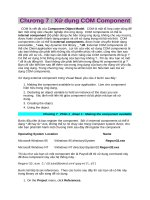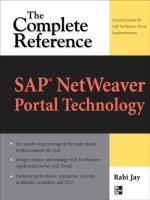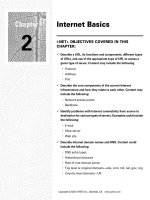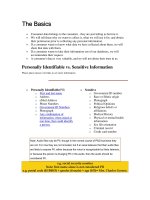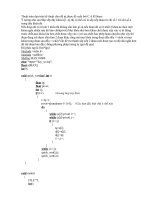Tài liệu SAP Basic
Bạn đang xem bản rút gọn của tài liệu. Xem và tải ngay bản đầy đủ của tài liệu tại đây (1.66 MB, 100 trang )
SAP2000
®
Linear and Nonlinear
Static and Dynamic
Analysis and Design
of
Three-Dimensional Structures
BASIC ANALYSIS REFERENCE
COMPUTERS &
STRUCTURES
INC.
Computers and Structures, Inc.
Berkeley, California, USA
Version 8.0
June 2002
1
COPYRIGHT
The computer program SAP2000 and all associated documentation are
proprietary and copyrighted products. Worldwide rights of ownership
rest with Computers and Structures, Inc. Unlicensed use of the program
or reproduction of the documentation in any form, without prior written
authorization from Computers and Structures, Inc., is explicitly prohib
-
ited.
Further information and copies of this documentation may be obtained
from:
Computers and Structures, Inc.
1995 University Avenue
Berkeley, California 94704 USA
tel: (510) 845-2177
fax: (510) 845-4096
e-mail:
web: www.csiberkeley.com
© Copyright Computers and Structures, Inc., 1978–2002.
The CSI Logo is a registered trademark of Computers and Structures, Inc.
SAP2000 is a registered trademark of Computers and Structures, Inc.
2
DISCLAIMER
CONSIDERABLE TIME, EFFORT AND EXPENSE HAVE GONE
INTO THE DEVELOPMENT AND DOCUMENTATION OF
SAP2000. THE PROGRAM HAS BEEN THOROUGHLY TESTED
AND USED. IN USING THE PROGRAM, HOWEVER, THE USER
ACCEPTS AND UNDERSTANDS THAT NO WARRANTY IS EX
-
PRESSED OR IMPLIED BY THE DEVELOPERS OR THE DIS
-
TRIBUTORS ON THE ACCURACY OR THE RELIABILITY OF
THE PROGRAM.
THE USER MUST EXPLICITLY UNDERSTAND THE ASSUMP
-
TIONS OF THE PROGRAM AND MUST INDEPENDENTLY VER-
IFY THE RESULTS.
3
ACKNOWLEDGMENT
Thanks are due to all of the numerous structural engineers, who over the
years have given valuable feedback that has contributed toward the en
-
hancement of this product to its current state.
Special recognition is due Dr. Edward L. Wilson, Professor Emeritus,
University of California at Berkeley, who was responsible for the con
-
ception and development of the original SAP series of programs and
whose continued originality has produced many unique concepts that
have been implemented in this version.
4
Table of Contents
Chapter I Introduction 1
About This Manual ............................1
Topics ...................................2
Typographic Conventions.........................2
Bibliographic References .........................3
Chapter II Objects and Elements 5
Chapter III Coordinate Systems 7
Overview .................................7
Global Coordinate System ........................8
Upward and Horizontal Directions ....................8
Local Coordinate Systems ........................9
Chapter IV The Frame Element 11
Overview.................................12
Joint Connectivity ............................13
Joint Offsets.............................13
Degrees of Freedom ...........................14
Local Coordinate System ........................14
Longitudinal Axis 1.........................15
Default Orientation .........................15
Coordinate Angle ..........................15
Section Properties ............................17
Local Coordinate System ......................17
i
5
Material Properties .........................17
Geometric Properties and Section Stiffnesses ...........17
Shape Type .............................18
Automatic Section Property Calculation ..............20
Section Property Database Files ..................20
Insertion Point ..............................22
End Offsets ...............................24
Clear Length ............................24
Effect upon Internal Force Output .................25
Effect upon End Releases......................25
End Releases...............................26
Unstable End Releases .......................27
Effect of End Offsets ........................27
Mass ...................................27
Self-Weight Load ............................28
Concentrated Span Load.........................28
Distributed Span Load..........................29
Loaded Length ...........................29
Load Intensity............................32
Internal Force Output ..........................32
Effect of End Offsets ........................34
Chapter V The Shell Element 35
Overview.................................36
Joint Connectivity ............................37
Degrees of Freedom ...........................40
Local Coordinate System ........................40
Normal Axis 3 ...........................41
Default Orientation .........................41
Coordinate Angle ..........................41
Section Properties ............................42
Section Type ............................43
Thickness Formulation .......................43
Material Properties .........................44
Thickness ..............................44
Mass ...................................45
Self-Weight Load ............................45
Uniform Load ..............................45
Internal Force and Stress Output ....................46
ii
SAP2000 Basic Analysis Reference
6
Chapter VI Joints and Degrees of Freedom 49
Overview.................................50
Modeling Considerations ........................51
Local Coordinate System ........................52
Degrees of Freedom ...........................52
Available and Unavailable Degrees of Freedom ..........53
Restrained Degrees of Freedom ..................54
Constrained Degrees of Freedom..................54
Active Degrees of Freedom.....................54
Null Degrees of Freedom ......................55
Restraints and Reactions.........................55
Springs..................................57
Masses ..................................58
Force Load................................59
Ground Displacement Load .......................59
Restraint Displacements ......................61
Spring Displacements........................61
Chapter VII Joint Constraints 65
Overview.................................65
Diaphragm Constraint ..........................66
Joint Connectivity..........................66
Plane Definition...........................67
Local Coordinate System ......................68
Constraint Equations ........................68
Chapter VIII Static and Dynamic Analysis 69
Overview.................................70
Loads...................................70
Load Cases .............................70
Acceleration Loads .........................71
Analysis Cases..............................71
Linear Static Analysis ..........................72
Modal Analysis .............................72
Eigenvector Analysis ........................73
Ritz-vector Analysis ........................74
Modal Analysis Results.......................75
Response-Spectrum Analysis ......................77
Local Coordinate System ......................78
iii
Table of Contents
7
Response-Spectrum Functions ...................78
Response-Spectrum Curve .....................79
Modal Combination.........................80
Directional Combination ......................82
Response-Spectrum Analysis Results ...............83
Chapter IX Bibliography 85
iv
SAP2000 Basic Analysis Reference
8
Chapter I
Introduction
SAP2000 is the latest and most powerful version of the well-known SAP series of
structural analysis programs.
About This Manual
This manual describes the basic and most commonly used modeling and analysis
features offered by the SAP2000 structural analysis program. It is imperative that
you read this manual and understand the assumptions and procedures used by the
program before attempting to create a model or perform an analysis.
The complete set of modeling and analysis features is described in the SAP2000
Analysis Reference.
As background material, you should first read chapter “The Structural Model” in
the SAP2000 Getting Started manual earlier in this volume. It describes the overall
features of a SAP2000 model. The present manual (Basic Analysis Reference ) will
provide more detailon some ofthe elements, properties, loads, and analysis types.
About This Manual
1
9
Topics
Each chapter of this manual is divided into topics and subtopics. Most chapters be
-
gin with a list of topics covered. Following the list of topics is an Overview which
provides a summary of the chapter.
Typographic Conventions
Throughout this manual the following typographic conventions are used.
Bold for Definitions
Bold roman type (e.g., example) is used whenever a new term or concept is de
-
fined. For example:
The global coordinate system is a three-dimensional, right-handed, rectangu-
lar coordinate system.
This sentence begins the definition of the global coordinate system.
Bold for Variable Data
Bold roman type (e.g., example) is used to represent variable data items for which
you must specify values when defining a structural model and its analysis. For ex-
ample:
The Frame element coordinate angle, ang, is used to define element orienta
-
tions that are different from the default orientation.
Thus you will need to supply a numeric value for the variable ang if it is different
from its default value of zero.
Italics for Mathematical Variables
Normal italic type (e.g., example) is used for scalar mathematical variables, and
bold italic type (e.g., example) is used for vectors and matrices. If a variable data
item is used in an equation, bold roman type is used as discussed above. For exam
-
ple:
0 £ da < db £ L
Here da and db are variables that you specify, and L is a length calculated by the
program.
2
Topics
SAP2000 Basic Analysis Reference
10
Italics for Emphasis
Normal italic type (e.g., example) is used to emphasize an important point, or for
the title of a book, manual, or journal.
All Capitals for Literal Data
All capital type (e.g., EXAMPLE) is used to represent data that you type at the key
-
board exactly as it is shown, except that you may actually type lower-case if you
prefer. For example:
SAP2000
indicates that you type “SAP2000” or “sap2000” at the keyboard.
Capitalized Names
Capitalized names (e.g., Example) are used for certain parts of the model and its
analysis which have special meaning to SAP2000. Some examples:
Frame element
Diaphragm Constraint
Frame Section
Load Pattern
Common entities, such as “joint” or “element” are not capitalized.
Bibliographic References
References are indicated throughout this manual by giving the name of the
author(s) and the date of publication, using parentheses. For example:
See Wilson and Tetsuji (1983).
It has been demonstrated (Wilson, Yuan, and Dickens, 1982) that ...
All bibliographic references are listed in alphabetical order in Chapter “Bibliogra
-
phy” (page 85).
Bibliographic References
3
Chapter I Introduction
11
4
Bibliographic References
SAP2000 Basic Analysis Reference
12
Chapter II
Objects and Elements
The physical structural members in a SAP2000 model are represented by objects.
Using the graphical user interface, you “draw” the geometry of an object, then “as-
sign” properties and loads to the object to completely define the model of the physi-
cal member.
The following objecttypes are available, listed in order of geometrical dimension:
•
Point objects, of two types:
–
Joint objects: These are automatically created at the corners or ends of all
other types of objects below, and they can be explicitly added to model
supports or other localized behavior.
–
Grounded (one-joint) link objects: Used to model special support behav
-
ior such as isolators, dampers, gaps, multilinear springs, and more. These
are not covered in this manual
•
Line objects, of two types
–
Frame/cable objects: Used to model beams, columns, braces, trusses,
and/or cable members
–
Connecting (two-joint) link objects: Used to model special member be
-
havior such as isolators, dampers, gaps, multilinear springs, and more. Un
-
5
13
like frame/cable obejcts, connencting link objects can have zero length.
These are not covered in this manual.
•
Area objects: Used to model walls, floors, and other thin-walled members, as
well as two-dimensional solids (plane stress, plane strain, and axisymmetric
solids). Only shell-type area objects are covered in this manual
•
Solid objects: Used to model three-dimensional solids. These are not covered
in this manual.
As a general rule, the geometry of the object should correspond to that of the physi
-
cal member. This simplifies the visualization of the model and helps with the de
-
sign process.
If you have experience using traditional finite element programs, including earlier
versions of SAP2000, you are probably used to meshing physical models into
smaller finite elements for analysis purposes. Object-based modeling largely elimi
-
nates the need for doing this.
For users who are new to finite-element modeling, the object-based concept should
seem perfectly natural.
When you run an analysis, SAP2000 automatically converts your object-based
model into an element-based model that is used for analysis. This element-based
model is called the analysis model, and it consists of traditional finite elements and
joints (nodes). Resultsof the analysis are reported back on the object-based model.
You have control over how the meshing is performed, such as the degree of refine-
ment, and how to handle the connections between intersecting objects. You also
have the option to manually mesh the model, resulting in a one-to-one correspon
-
dence between objects and elements.
In this manual, the term “element” will be used more often than “object”, since
what is described herein is the finite-element analysis portion of the program that
operates on the element-based analysis model. However, it should be clear that the
properties described here for elements are actually assigned in the interface to the
objects, and the conversion to analysis elements is automatic.
SAP2000 Basic Analysis Reference
6
14
Chapter III
Coordinate Systems
Each structure may use many different coordinate systems to describe the location
of points and the directions of loads, displacement, internal forces, and stresses.
Understanding these different coordinate systems is crucial to being able to prop-
erly define the model and interpret the results.
Topics
•
Overview
•
Global Coordinate System
•
Upward and Horizontal Directions
•
Local Coordinate Systems
Overview
Coordinate systems are used to locate different parts of the structural model and to
define the directions of loads, displacements, internal forces, and stresses.
All coordinate systems in the model are defined with respect to a single, global
X-Y-Z coordinate system. Each part of the model (joint, element, or constraint) has
its own local 1-2-3 coordinate system. In addition, you may create alternate coordi
-
Overview
7
15
nate systems that are used to definelocations and directions. All coordinate systems
are three-dimensional, right-handed, rectangular (Cartesian) systems.
SAP2000 always assumes that Z is the vertical axis, with +Z being upward. The up
-
ward direction is used to help define local coordinate systems, although local coor
-
dinate systems themselves do not have an upward direction.
For more information and additional features, see Chapter “Coordinate Systems” in
the SAP2000 Analysis Reference and the Help Menu in the SAP2000 graphical user
interface.
Global Coordinate System
The global coordinate system is a three-dimensional, right-handed, rectangular
coordinate system. The three axes, denoted X, Y, and Z, are mutually perpendicular
and satisfy the right-hand rule. The location and orientation of the global system are
arbitrary.
Locations in the global coordinate system can be specified using the variables x, y,
and z. A vector in the global coordinate system can be specified by giving the loca-
tions of two points, a pair of angles, or by specifying a coordinate direction. Coordi-
nate directions are indicated using the values X, Y, and Z. For example, +X de-
fines a vectorparallel to anddirected along the positive X axis. The sign is required.
All other coordinate systems in the model are defined with respect to the global co-
ordinate system.
Upward and Horizontal Directions
SAP2000 always assumes that Z is the vertical axis, with +Z being upward. Local
coordinate systems for joints, elements, and ground-acceleration loading are de
-
fined with respect to this upward direction. Self-weight loading always acts down
-
ward, in the –Z direction.
The X-Y plane is horizontal. The primary horizontal direction is +X. Angles in the
horizontal plane are measured from the positive half of the X axis, with positive an
-
gles appearing counter-clockwise when you are looking down at the X-Y plane.
8
Global Coordinate System
SAP2000 Basic Analysis Reference
16
Local Coordinate Systems
Each part (joint, element, or constraint) of the structural model has its own local co
-
ordinate system used to define the properties, loads, and response for that part. The
axes of the local coordinate systems are denoted 1, 2, and 3. In general, the local co
-
ordinate systems may vary from joint to joint, element to element, and constraint to
constraint.
There is no preferred upward direction for a local coordinate system. However, the
joint and element local coordinate systems are definedwith respect to the global up
-
ward direction, +Z.
The joint local 1-2-3 coordinate system is normally the same as the global X-Y-Z
coordinate system.
For the Frame and Shell elements, one of the element local axes is determined by
the geometry of the individual element. You may define the orientation of the re-
maining two axes by specifying a single angle of rotation.
The local coordinate system for a Diaphragm Constraint is normally determined
automatically from the geometry or mass distribution of the constraint. Optionally,
you may specify one global axis that determines the plane of a Diaphragm Con-
straint; the remaining two axes are determined automatically.
For more information:
• See Topic “Local Coordinate System” (page 14) in Chapter “The Frame Ele-
ment.”
•
See Topic “Local Coordinate System” (page 40) in Chapter “The Shell Ele
-
ment.”
•
See Topic “Local Coordinate System” (page 52) in Chapter “Joints and De
-
grees of Freedom.”
•
See Topic “Diaphragm Constraint” (page 66) in Chapter “Joint Constraints.”
Local Coordinate Systems
9
Chapter III Coordinate Systems
17
10
Local Coordinate Systems
SAP2000 Basic Analysis Reference
18
Chapter IV
The Frame Element
The Frame element is used to model beam-column and truss behaviorin planar and
three-dimensional structures. The frame element can also be used to model cable
behavior when nonlinear properties are added (e.g., tensiononly, large deflections).
Although everything described in this chapter can apply to cables, cable-specific
behavior is not discussed.
Topics
•
Overview
•
Joint Connectivity
•
Degrees of Freedom
•
Local Coordinate System
•
Section Properties
•
Insertion Point
•
End Offsets
•
End Releases
•
Mass
•
Self-Weight Load
•
Concentrated Span Load
11
19
•
Distributed Span Load
•
Internal Force Output
Overview
The Frame element uses a general, three-dimensional, beam-column formulation
which includes the effects of biaxial bending, torsion, axial deformation, and bi
-
axial shear deformations. See Bathe and Wilson (1976).
Structures that can be modeled with this element include:
•
Three-dimensional frames
•
Three-dimensional trusses
•
Planar frames
• Planar grillages
• Planar trusses
• Cables
A Frame element is modeled as a straight line connecting two points. In the graphi-
cal user interface, you can divide curved objects into multiple straight objects,
subject to your specification.
Each element has its own local coordinate system for defining section properties
and loads, and for interpreting output.
Each Frame element may be loaded by self-weight, multiple concentrated loads,
and multiple distributed loads.
Insertion points and end offsets are available to account for the finite size of beam
and column intersections. End releases are also available to model different fixity
conditions at the ends of the element.
Element internal forces are produced at the ends of each element and at a user-spec
-
ified number of equally-spaced output stations along the length of the element.
Cable behavior is modeled using the frame element and adding the appropriate fea
-
tures. You can release the moments at the ends of the elements, although we recom
-
mend that you retain small, realistic bending stiffness instead. You can also add
nonlinear behavior as needed, such as the no-compression property, tension stiffen
-
ing (p-delta effects), and large deflections. These features require nonlinear analy
-
sis, and are not covered in this manual.
12
Overview
SAP2000 Basic Analysis Reference
20
For more information and additional features, see Chapter “The Frame Element” in
the SAP2000 Analysis Reference.
Joint Connectivity
A Frame element is represented by a straight line connecting two joints, i and j,un
-
less modified by joint offsets as described below. The two joints must not share the
same location in space. The two ends of the element are denoted end I and end J, re
-
spectively.
By default, the neutral axis of the element runs along the line connecting the two
joints. However, you can change this using the insertion point, as described in
Topic “Insertion Point” (page 22).
Joint Offsets
Sometimes the axis of the element cannot be conveniently specified by joints that
connect to other elements in the structure. You have the option to specify joint off-
sets independently at each end of the element. These are given as the three distance
components (X, Y, and Z) parallel to the global axes, measured from the joint to the
end of the element (at the insertion point.)
The two locations given by the coordinates of joints i and j, plus the corresponding
joint offsets, define the axis of the element. These two locations must not be coinci-
dent. It is generally recommended that the offsets be perpendicular to the axis of the
element, although this is not required.
Offsets along the axis of the element are usually specified using end offsets rather
than joint offsets. See topic “End Offsets” (page 24). End offsets are part of the
length of the element, have element properties and loads, and may or may not be
rigid. Joint offsets are external to the element, and do not have any mass or loads.
Internally the program creates a fully rigid constraint along the joints offsets.
Joint offsets are specified along with the cardinal point as part of the insertion point
assignment, even though they are independent features.
For more information:
•
See Topic “Insertion Point” (page 22) in this chapter.
•
See Topic “End Offsets” (page 24) in this chapter.
Joint Connectivity
13
Chapter IV The Frame Element
21
Degrees of Freedom
The Frame element activates all six degrees of freedom at both of its connected
joints. If you want to model truss or cable elements that do not transmit moments at
the ends, you may either:
•
Set the geometric Section properties j, i33, and i22 all to zero (a is non-zero;
as2 and as3 are arbitrary), or
•
Release both bending rotations, R2 and R3, at both ends and release the tor
-
sional rotation, R1, at either end
For more information:
•
See Topic “Degrees of Freedom” (page 52) in Chapter “Joints and Degrees of
Freedom.”
• See Topic “Section Properties” (page 17) in this chapter.
• See Topic “End Releases” (page 26) in this chapter.
Local Coordinate System
Each Frame element has its own element local coordinate system used to define
section properties, loads and output. The axes of this local system are denoted 1, 2
and 3. The first axis is directed along the length of the element; the remaining two
axes lie in the plane perpendicular to the element with an orientation that you spec-
ify.
It is important that you clearly understand the definition of the element local 1-2-3
coordinate system and its relationship to the global X-Y-Z coordinate system. Both
systems are right-handed coordinate systems. It is up to you to define local systems
which simplify data input and interpretation of results.
In most structures the definition of the element local coordinate system is extremely
simple using the default orientation and the Frame element coordinate angle.
Additional methods are available.
For more information:
•
See Chapter “Coordinate Systems” (page 7) for a description of the concepts
and terminology used in this topic.
•
See Topic “Advanced Local Coordinate System” in Chapter “The Frame Ele
-
ment” in the SAP2000 Analysis Reference.
14
Degrees of Freedom
SAP2000 Basic Analysis Reference
22
•
See Topic “Joint Offsets” (page 13) in this chapter.
Longitudinal Axis 1
Local axis 1 is always the longitudinal axis of the element, the positive direction be
-
ing directed from end I to end J.
Specifically, end I is joint i plus its joint offsets (if any), and end J is joint j plus its
joint offsets (if any.) The axis is determined independently of the cardinal point; see
Topic “Insertion Point” (page 22.)
Default Orientation
The default orientation of the local 2 and 3 axes is determined by the relationship
between the local 1 axis and the global Z axis:
• The local 1-2 plane is taken to be vertical, i.e., parallel to the Z axis
• The local 2 axis is taken to have an upward (+Z) sense unless the element isver-
tical, in which case the local 2 axis is taken to be horizontal along the global +X
direction
• The local 3 axis is always horizontal, i.e., it lies in the X-Y plane
An element is considered to be vertical if the sine of the angle between the local 1
axis and the Z axis is less than 10
-3
.
The local 2 axis makes the same angle with the vertical axis as the local 1 axis
makes with the horizontal plane. This means that the local 2 axis points vertically
upward for horizontal elements.
Coordinate Angle
The Frame element coordinate angle, ang, is used to define element orientations
that are different from the default orientation. It is the angle through which the local
2 and 3 axes are rotated about the positive local 1 axis from the default orientation.
The rotation for a positive value of ang appears counter-clockwise when the local
+1 axis is pointing toward you.
For vertical elements, ang is the angle between the local 2 axis and the horizontal
+X axis. Otherwise, ang is the angle between the local 2 axis and the vertical plane
containing the local 1 axis. See Figure 1 (page 16) for examples.
Local Coordinate System
15
Chapter IV The Frame Element
23
16
Local Coordinate System
SAP2000 Basic Analysis Reference
Figure 1
The Frame Element Coordinate Angle with Respect to the Default Orientation
24
Section Properties
A Frame Section is a set of material and geometric properties that describe the
cross-section of one or more Frame elements. Sections are defined independently
of the Frame elements, and are assigned to the elements.
Local Coordinate System
Section properties are defined with respect to the local coordinate system of a
Frame element as follows:
•
The 1 direction is along the axis of the element. It is normal to the Section and
goes through the intersection of the two neutral axes of the Section.
•
The 2 and 3 directions define the plane of the Section. Usually the 2 direction is
taken along the major dimension (depth) of the Section, and the 3 direction
along its minor dimension (width), but this is not required.
See Topic “Local Coordinate System” (page 14) in this chapter for more informa-
tion.
Material Properties
The material properties for the Section are specified by reference to a previously-
defined Material. The material properties used by the Section are:
•
The modulus of elasticity, e1, for axial stiffness and bending stiffness;
•
The shear modulus, g12, for torsional stiffness and transverse shear stiffness;
this is computed from e1 and the Poisson's ratio, u12
•
The mass density (per unit of volume), m, for computing element mass;
•
The weight density(per unit ofvolume), w, for computing Self-Weight Load.
•
The design-type indicator, ides, that indicates whether elements using this Sec
-
tion should be designed as steel, concrete, or neither (no design).
Geometric Properties and Section Stiffnesses
Six basic geometric properties are used, together with the material properties, to
generate the stiffnesses of the Section. These are:
•
The cross-sectional area,a. The axial stiffness of the Section is given by
ae1×
;
Section Properties
17
Chapter IV The Frame Element
25




